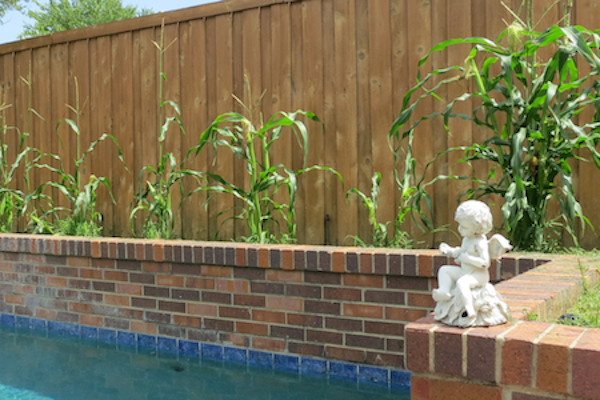Three months ago, I became an urban farmer. Today, our tiny backyard is almost 100% edible — planted with tomatoes, okra, peppers, cucumbers, yellow squash, swiss chard, eggplants, radishes, green onions, lettuce, arugula, peas, herbs, and even corn.

We are farming six one-thousandths of an acre all-in-all. When I committed to turning our backyard into a farm (the front yard is next), I knew I had a lot to learn and more than a few bad habits to overcome. (I’m a city girl who hates to sweat and lacks patience.)
I also knew it wouldn’t all go smoothly. (Which of course was oh-so-true.) Another fact: I love infographics. When I came across this one about what, how, and when to plant vegetables, I thought I’d share. Keep reading after the pic for a few of my own lessons learned.
“A Gardener’s Cheat Sheet” Infographic
This caught my eye for a few reasons. It lays out what vegetables you can plant in the ground and in pots and when to plant and harvest them. Did you know planting certain plants near each other helps protect some of your vegetables from common (and destructive) pests?
It’s called companion planting — and this infographic shares what you should plant with what for optimal, pest-free results. Keep in mind that growing varies based on where you plant and the conditions at that particular time, but this is a really nice nibble of edible education.
4 Lessons I’ve Learned in 3 Months as an Urban Farmer
I’ve learned so much — from what to wear, what tools to use, and a lot of what not to do. Here are a few of my lessons on what, how, and when to plant vegetables…
1. Unless you need a large quantity of produce or you have loads of friends to give your food to, don’t overplant a particular vegetable or herb.
I could eat swiss chard everyday and not use it all. (And frankly, I don’t even like it that much, but it’s awful pretty.) Avoid food waste by really thinking about what you will do with the fruits of your labor.
2. Just because a seed packet says it was packed for an earlier year doesn’t mean those seeds won’t sprout.
I had seeds going back as far as 2010. Stuck ’em in my seed starter, and bam. They grew.
3. Natural pest control is really difficult.
That’s why I’m going to try companion planting next year. My organized brain thinks that all herbs should be in one place, tomatoes in another, etcetera. But this infographic and other information I’ve learned have taught me that planting certain things together can reduce pests. Note: This infographic doesn’t touch on herbs, but there are a lot of herb-vegetable combos — like tomatoes and basil — that go well together. Check out this much more comprehensive guide to companion planting in a recent Becky Striepe post.
4. I won’t start seeds indoors again unless I absolutely have to.
Epic fail for me. I bought a large, self-watering seed starter system and planted lots of seeds inside (including some that could’ve been direct sowed outside). I did this because I had a lot of weeding and prepping to do before I could plant most of my backyard crops, and I didn’t want to miss my planting window. The seeds grew at different rates (duh), so I couldn’t start hardening them off outside at the same time. And that hardening-off process really taxed my patience. Take ’em out, bring ’em in, take ’em out, bring ’em in. Don’t put them in too much direct sunlight. Put a fan on them when they’re inside. Ugh!
I hope you find this information useful and entertaining. What are some of the lessons you’ve learned on your own urban farm? Image Credit: Mary Gerush (That’s my corn field.) | Infographic Credit: Good to be Home











































Once again great information. Thanks
This is excellent info. I, too, am a failure with seeds–maybe it’s genetic?
Can you order the cheat sheet?
You never plant one row of corn. It needs to be planted in a plot in order to cross pollinate.